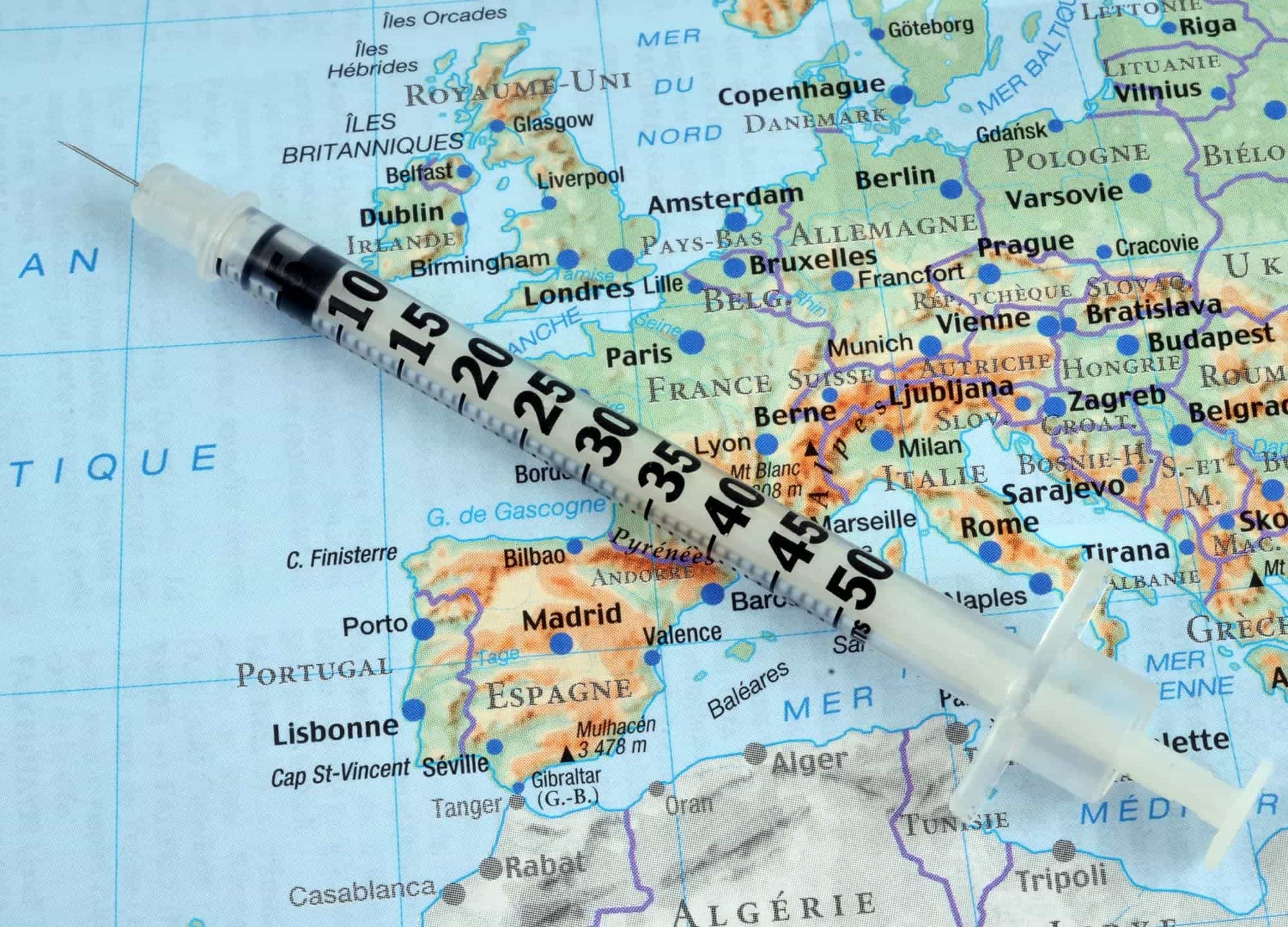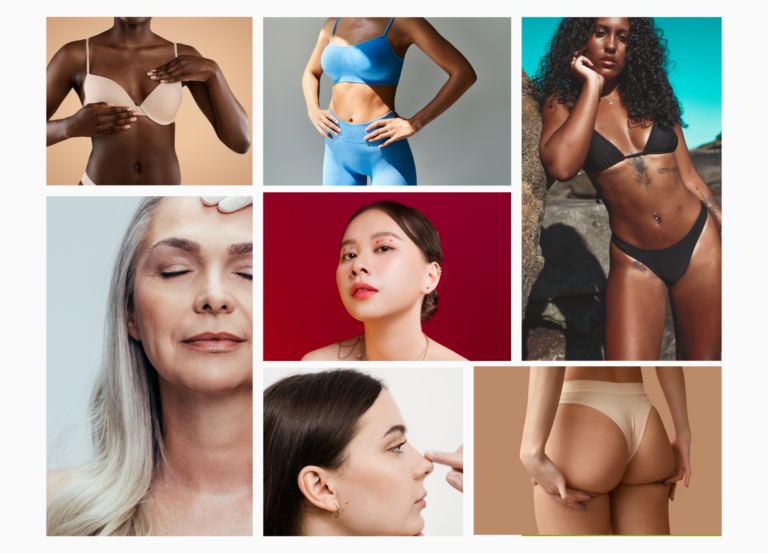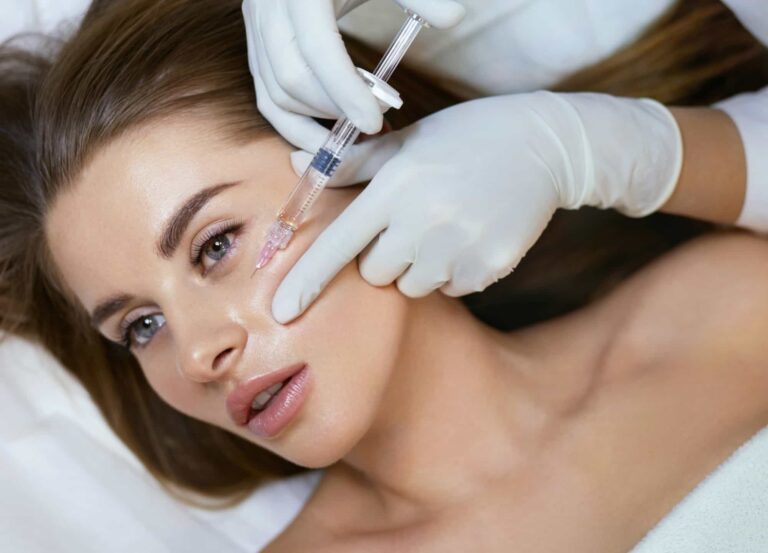After nearly two years of pandemic living, wanderlust is epidemic. But for those who haven’t yet renewed their passports, quelling that travel itch may mean getting your foreign-affairs fix from home or wherever you happen to be. Aiming to satisfy your global beauty curiosities, we DM’d some of our favorite international cosmetic doctors to see what’s currently trending in their faraway practices. While top treatments vary from place to place, patients’ goals are largely identical: smooth, luminous skin and fine-tuned features that look natural.
In certain parts of the world, the year’s most coveted tweaks mirror those we’ve recently tried here in the States (who doesn’t love microneedling?). In other plastic surgery hot spots, folks are clamoring for buzzy injectables that aren’t yet approved in America (hello, skin boosters!)—but that doesn’t mean we can’t enjoy a vicarious glow.
Ahead, sought-after doctors from around the world share the procedures that are most popular in their own backyards.
1. London
Provider: Dr. Sophie Shotter, an aesthetics physician in Kent and London
Botox and fillers
“Botox has been the most requested aesthetic treatment for years now—and many people rave about how much better they feel after having Botox. Following on from a tough 18 months, Botox is as popular as ever, helping people to look and feel their best. Fillers are pretty much as popular as Botox in my practice. During lockdown, I think people became increasingly aware of their appearance—sagging skin, in particular. This has coincided with improved patient education around treatments and patients realizing how natural aesthetic treatments can look. For me, fillers are the most impactful treatment I do, largely because of the immediacy of the result. I love showing patients a fifty-fifty [view], with half the face treated and the other half not. They see how much fresher they look whilst still looking like themselves.”
Profound RF
“The conversation around RF microneedling has [grown] over the past year, and we have a lot of patients requesting the Profound RF. For a week of downtime, patients can achieve a third of a surgical facelift in a single treatment. During COVID-19, more people have been able to tolerate a little downtime, thanks to mask wearing, and so the procedure has boomed in my practice.”
Provider: Dr. Ashwin Soni, a plastic and reconstructive surgeon in Surrey and Berkshire
Upper blepharoplasty
“I have observed that blepharoplasties are increasing significantly in popularity in my practice, especially upper blepharoplasties. The reason behind this is that the eyelids are an area that cannot be addressed with nonsurgical treatments, especially when it comes to the hooding and excess skin of the upper eyelids. There are some lower eyelid cases that can now be addressed with filler treatment, but not the upper eyelids.”
Abdominal toning with Emsculpt
“Body sculpting technology, now combining high-intensity electromagnetic energy with radiofrequency, has become the next machine for high-end clinics to invest in. While Emsculpt and Emsculpt Neo are the most popular here, there are many companies out there that have developed this technology, and it is a nice adjunct to have in a facial aesthetics clinic. The technology, which has taken the UK by storm, has improved significantly over the years, scientifically demonstrating the capabilities of muscle building and fat reduction simultaneously.”
2. Sydney
Provider: Dr. Naomi McCullum, a cosmetic physician in Sydney
Short thread lifts
“One of our top requested procedures is short thread lifts, [which] work by stimulating collagen rather than lifting, like long threads. With filler, so many patients worry about ‘puffiness’ or too much volume in the wrong place—these issues can’t happen with short threads. The results are always natural. The threads are also low-risk and suitable for all skin types. The bruising can be quite significant after short threads, but the swelling is much less than with the long threads. We also find the satisfaction rate is higher with the short thread lifting versus the long thread lifts. They have a really high retention rate—people who have them once want them again.”
Body muscle slimming
“A new procedure that we have introduced over the past few years is body muscle slimming. We use botulinum toxin to shrink the trapezius muscle or the calves, the biceps or deltoid muscles. The upper body muscle slimming is gaining popularity in the trans-female community, as they often love a smaller and more petite look. It can be a life-changing procedure, in some cases.
“The amount of slimming effect per treatment comes down to the dose used, so the larger the dose, the more the noticeable effect. Patients often have budgetary constraints, so this can limit the amount used, as can issues related to safety in dosing. In general, the patient will start getting very inspired by their new look after three treatments, although this can happen with one as well, depending on dose.”
Nonsurgical penis enlargement
“Nonsurgical penis enlargement is a relatively new procedure that’s growing in popularity, with gay men in particular. Filler is injected into the penis, to improve the girth. This is another procedure with a high retention rate—if a patient has their penis filled once, they love the new look and generally want more. The risks are similar to [those with] fillers [injected elsewhere], so the bruising and swelling and the more catastrophic ones, like infection or necrosis.”
Bespoke facial optimization
“The top thing that people come to our clinic for is total face design, so it’s not the individual procedures themselves but the overall multimodality design/plan and transformation. It’s totally bespoke to the patient and can include all the nonsurgical options—toxin, filler, threads, fat dissolving, lipo, resurfacing, lump and bump removal from skin, energy-based devices. It all comes down to what needs to be done to create the ideal look for the particular patient.”
3. Nice, France
Provider: Dr. Yves Saban, a facial plastic and maxillofacial surgeon in Nice
Preservation rhinoplasty
“For many rhinoplasty surgeons, the concept of preservation rhinoplasty and, especially, dorsal preservation is still new. [The technique aims to preserve the natural look of the nose by conservatively removing bone and cartilage from underneath the dorsum, to lower the bridge rather than taking tissue from the top and changing its appearance.] Many consider it to be a radical departure from conventional reduction techniques. However, this technique is not truly new—it was first published in 1898 by Goodale, to my knowledge. So, it’s better [to] talk about [it as] a renaissance.
“Rhinoplasty surgeons have begun to realize the aesthetic and functional consequences of destroying the keystone area—that is, the anatomic structure forming the nasal bridge. Why should we reconstruct something if we can preserve it? Classic rhinoplasty techniques consist of resecting the nasal dorsum, to lower the nasal height. Then you must rebuild a new one in order to show a natural shape and to get a satisfying breathing. After resection, many issues may happen—inverted V deformity, pollybeak deformity, visibility of bony edges—thus making a surgical-looking appearance.
“One of the best advantages of the preservation procedures is that almost all patients will show a natural nose, without any surgical look. After the surgery, the feedback from family and friends is: ‘You look much better.’ ‘Did you enjoy vacation?’ ‘Did you change your makeup?’ ‘Your eyes are shining!’ Almost never any feedback about a nose job. Privacy is preserved.
“Another enormous advantage of the preservation techniques is that in the case of revision—which still can happen in about 10% of cases—the surgeon will face a quasi-untouched nose, thus they will be able to perform whatever the procedure in the same way as in primary rhinoplasty. No need for rib graft harvesting and no need to spend three to six hours in nose reconstruction.”
4. Munich
Provider: Dr. Timm Golueke, a board-certified dermatologist in Munich
Ultraformer + PRP + micro-Botox
“It is mainly about the eye area and the neck right now—we all have tech neck from looking at our devices all day long.
“For the eye area, I recommend Ultraformer III—noninvasive microfocused ultrasound—to activate collagen production, in combination with platelet-rich plasma (PRP) and micro-Botox for crow’s-feet. For the Ultraformer III, we do three sessions, every two weeks, for wrinkles under the eye, bags, and dark circles, along with two or three sessions of PRP, which also work against dark circles, dullness, and wrinkles under the eyes.”
Radiofrequency microneedling + Profhilo
“For the neck, RF microneedling in combination with Profhilo—an injectable skin-enhancing treatment—shows great results. Instead of Profhilo’s HA molecules being chemically crosslinked, as with traditional fillers, they’re stabilized by a special heating process. It dissolves like honey under the skin, with no lumps or nodules. For me, it’s the only filler that works on the neck. It does the job of plumping wrinkles [while also] stimulating the production of collagen and elastin and amplifying hydration, to improve skin quality for up to six months.”
5. Amsterdam
Provider: Dr. Tom Van Eijk, an aesthetics physician in Amsterdam
Skin boosters + fern pattern technique
“Treatments in the fall are traditionally focused on the repair of sun-damaged skin. Skin boosters such as Profhilo and Restylane Silk dominate the agenda these weeks.
“Restylane Silk is excellent for the treatment of visible sun damage, such as fine lines, and most candidates for that will be 30 and over. Profhilo can be used even with a younger crowd, before lines appear, to replenish the skin’s hyaluronic acid and moisture level. The effect on the skin looks like you found very potent skin care—although skin care can never be this spectacular, since hyaluronic acid molecules are simply too big to permeate the dermis if you smear it on there—hence the injections.
“Profhilo has the ability to spread underneath the skin, which makes it a very simple and fast procedure. This spreading capacity also makes it the ideal solution for notoriously difficult indications, such as the neck and décolletage, where other injectables could be risky in terms of lumpiness. Restylane Silk is far more sturdy [and works well for] strengthening the skin when it’s injected into the dermis itself, using the fern pattern technique, which I invented in 2004 and have been perfecting ever since. Back then, the only way we were taught to inject hyaluronic acid was underneath the skin, to create volume. I found that injecting volume did not always give an aesthetically pleasing result—particularly in folds or lines.
“The ability of hyaluronic acid to strengthen the skin when injected superficially is the key to the fern pattern technique. Injections toward both sides of a fold, injecting from the fold itself, in the shape of a fern leaf, proved the most efficient way to strengthen the skin without adding volume. The amount of filler needed to strengthen the skin is far less than what one would use to volumize. For the patient, this means that the treatment will cost less than the traditional hyaluronic acid treatment. It will last longer too, since the patient’s own skin cells will be stimulated to create new collagen.
“Since this technique makes overfilling of faces obsolete, a more natural and predictable result can be obtained. It is the most logical answer to the loss of skin strength, such as in acne scars, sun damage, or aging skin.”
6. Dubai, United Arab Emirates
Provider: Dr. Dara Liotta, a board-certified facial plastic surgeon in New York City and Dubai
Nose jobs that spare the bump
“Rhinoplasty is always super-popular in Dubai, but the aesthetic there is very different from what I see in my New York office. In Dubai, many women actually like a bump. And they like the nose to be thin and long—they really don’t want to put the tip up at all. Usually they have a really big bump and they want to keep a bump but have it be a little more subtle. Or their nose is wide and they want to keep their bump but narrow the nose.
“Studying abroad is a big thing in the Middle East. A lot of women will study in Europe for a couple of years, have a rhinoplasty done while they’re away, and then come for a revision rhinoplasty when they return to the Middle East because they want me to give them back a bump and raise the bridge and kind of undo that European look.”
Small surgeries at younger ages
“They tend to be much more accepting of plastic surgery in the Middle East. They don’t care that much about a scar or recovery. And I generally see people who are younger having more plastic surgery and opting for a surgical fix rather than an injection. I’m constantly asked for lip lifts, brow lifts, and upper eyelid surgery. In Dubai, patients tend to have a little bit more hoodiness, a little bit of a heavier eyelid, so it’s common to get the upper lids done at a younger age. There, the procedure is more about enhancing than anti-aging.”
7. Mumbai, India
Provider: Dr. Jaishree Sharad, a board-certified dermatologist in Mumbai
Profhilo
“Profhilo is a new anti-aging procedure based on a skin bioremodeling approach. In this procedure, a highly pure form of hyaluronic acid is administered into different strategic points of the skin, to unleash the rejuvenation of the skin’s ability to generate collagen and elastin—the two scaffolding proteins critical to skin’s firmness and elasticity. A lunchtime procedure, Profhilo results in more youthful, firm, and radiant skin.”
Dermapen microneedling
“Microneedling is a treatment done [in our office] with an instrument called the Dermapen, which is a motorized device with medical-grade stainless steel needles attached to a pen-like structure. The patient’s skin is cleansed and a numbing cream applied for about 20 minutes. A hyaluronic acid gel is then applied to the entire face and neck before the pen is rolled on in a sequential manner to cover the entire face and neck, including the under-eyes and eyelids. This is followed by application of antioxidant cocktail serum, a vitamin-rich repair cream, a skin-brightening serum, or an application of PRP, depending on the patient’s need.
“Microneedling is safe for dark skin, unlike [certain] lasers. There is minimal downtime, it takes a day or two for the skin to heal. And treatment helps to reduce acne scars and improve uneven skin tone, pores, and fine lines.”
Skin boosters
“This treatment uses concentrated solutions of hyaluronic acid, such as Juvéderm Volite, Restylane Vital, and Belotero Revive, to hydrate the skin, boost collagen, and soften fine lines and dilated pores. After prepping the skin with a numbing cream, tiny injections are given all over the face. Skin boosters should not be mistaken for fillers. They are more like injectable moisturisers and anti-aging ingredients. They leave the skin feeling smooth and fresh and add significant radiance to the face. They can also be done on the neck and hands.”
8. Seoul, South Korea
Provider: Dr. Yunyoung Claire Chang, a board-certified dermatologist in New York City who travels to Seoul several times a year
Rejuran Healer injections
“This rejuvenation treatment is composed of purified polynucleotides, or DNA fragments derived from salmon, which are purported to not only improve skin hydration but also promote collagen and tissue regeneration. Rejuran injections are currently being used on all skin types to help skin elasticity and firmness, reduce the appearance of wrinkles and fine lines, reduce pore size, increase skin hydration, increase skin regeneration, and improve acne scars. Treatment requires topical numbing cream, to help with the discomfort of the injections, which may be quite painful. Most patients have small bumps over the whole treatment area for five to seven days, and there is a risk of bruising and swelling. Multiple monthly treatments are required, for optimal effects, as well as maintenance treatments approximately every six months.”
Threads for skin lifting and a V-shaped face
“While thread lifting is getting more popular in the States, it continues to be very popular in Korea, making up as much as 20% of cosmetic procedures performed in some clinical practices. Small suture-like threads are placed under the skin using a cannula. These threads typically have hooks, barbs, or cones on them, to help lift the treated skin. Side effects include pain, bruising, swelling, or temporary puckering of the skin, and inflammatory or allergic reactions.”
Thermage and Ultherapy
“Patients of all ages are getting minimally invasive skin tightening procedures as preventive treatment. Thermage uses radiofrequency to firm and tighten the skin, while Ultherapy uses microfocused ultrasound to stimulate collagen deep in the skin, to tighten and lift the treated areas. More patients are looking toward less invasive procedures for a more natural lift. In Korea, some clinics actually put you under general anesthesia for these procedures, since they are often painful. Possible side effects include swelling, redness, and soreness in the treated area. Bruising may occur with Ultherapy. Another reported side effect with Ultherapy includes fat loss in the treated area, though it is still unclear why and to whom this happens.”
Pico-toning
“Picosecond lasers help brighten and rejuvenate the skin and can target pigment as well as stimulate collagen to improve fine lines, uneven texture, enlarged pores, and acne scars. In Korea, patients do this treatment as frequently as every one to two weeks, to keep their skin bright and vibrant. Side effects include redness, swelling, and possible pinpoint bruising.”
9. Stockholm
Provider: Dr. Rebecka Gardell, an aesthetics physician in Stockholm
Restoring volume—without overfilling
“Addressing volume loss is among our most requested treatments at the moment. People want to look younger—but without risking looking overfilled. Many have had a bad experience with fillers. They’ve had or seen overfilled lips, migrated filler, too-big cheekbones, too much filler in the jawline that leads to a square and masculine-looking face, and so on.
“The fact is, filler is good for one thing and one thing only—restoring lost volume. When you age, you always lose volume in different areas of the face, and this makes a person look older. When we fill only in areas of volume loss and nowhere else, the result looks very natural, because those are places in the face where you used to have volume.
“I see some injectors who like to put a lot of filler in the cheekbones and jawline in order to ‘lift’ the rest of the face, but I don’t really believe in filler’s ability to lift—when using that strategy, it’s very common to instead overfill the face, making the cheeks and jawline too big.
“When I look at a face, I immediately identify areas of volume loss—the most common being the midface, the tear trough region, the inner nasolabial folds, the area below and beside the mouth, and also the temples. When you fill these areas with a moderate amount of filler—only to the extent that the volume loss is corrected and never more than that—the result is going to be a younger appearance.
“It’s important to keep in mind, of course, that filler does migrate with time and that it doesn’t always dissolve on its own; it can easily stay in the face for 10–15 years. When it migrates, it causes you to have volume in an area where you anatomically should not have volume, and this leads to an unnatural appearance that is associated with a fake or plastic look. If the filler migrates, you need to immediately remove it.
“Ultimately, you should not look like you’ve had filler, because we’ve increased the volume only in places where it existed earlier in life. Nobody suspects that you’ve done treatments—you just look fresh and rested, and this is what we see people wanting nowadays.”
Tear trough filler
“Tear trough filler—mainly Teosyal Redensity 2—is one of our most popular treatments. It addresses hollowness under the eyes, which is such a common problem for both men and women.
“To be able to achieve a good end result after tear trough filler, it’s very important to choose the correct candidate for this treatment and to thoroughly explain to the patient what kind of result they can achieve.
“The technique used is also crucial for the result. I believe the injector should work with a blunt cannula and never with a sharp needle in this delicate area. And they must choose the correct material or mix of materials and also use the correct amount.
“The filler needs to be placed in an extremely detailed manner, never putting too much in one place. Of course, the filler needs to be placed very deep, preferably on the bone, and not all injectors dare to go this deep so close to the eye. Only with vast experience and good knowledge of the anatomy can you do this safely.
“When the treatment is done in this way, the tear trough filler will correct the hollowness under the eyes without looking swollen, lumpy, overfilled, or discolored. The result is instead a bright, smooth, and fresh-looking under-eye area.”











